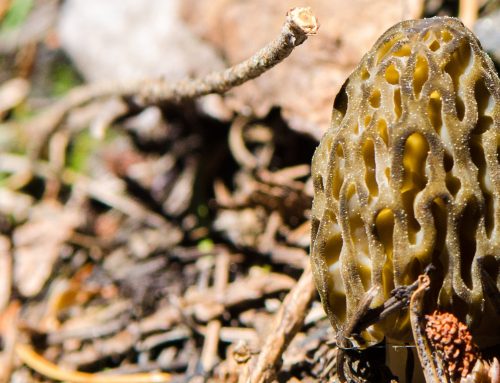The air has turned cooler, the leaves are changing colors, and we’ve experienced some rain putting an end to another long dry summer and marking the beginning of Autumn. To the forest-forager, that means there’s a new delicacy on the menu, Chanterelles. After only an hour or so spent this past weekend in the forests near Leavenworth with friends, I can confirm the chanterelles have arrived.

Cantharellus cibarius, commonly known as the chanterelle, or golden chanterelle, is a fungus that can appear orange, yellow, or even almost white, is meaty and has a distinctive funnel-shape. It emits a fruity aroma, reminiscent of apricots and a mildly peppery taste is considered an excellent edible mushroom. Chanterelles are relatively high in vitamin C, very high in potassium, and are among the richest sources of vitamin D known.
On the lower surface, underneath the smooth cap, Chanterelles have gill-like ridges that run almost all the way down its stipe, which tapers down seamlessly from the cap. They can range in size from being edible once they’re the size of your thumb, to larger than your outstretched hand. Chanterelles are mycorrhizal, meaning they associate with trees and possibly some other bushes or plants. No trees, no chanterelles. They tend to grow in clusters in mossy coniferous forests, but are also often found in mountainous birch forests and among grasses and low-growing herbs. A lot of moss is a good indicator some may be around, although they may not grow directly from the moss, they could be nearby.

Chanterelles are rich in flavor, with a distinctive taste and aroma that is somewhat difficult to characterize. Some species have a fruity odor, others a more woody, earthy fragrance, and still others can even be considered spicy. The golden chanterelle is perhaps the most sought-after and flavorful chanterelle, and many chefs consider it on the same short list of gourmet fungi as truffles and morels. It therefore tends to command a high price in both restaurants and specialty stores, though it can be found in abundance right now in the woods of the Pacific Northwest for free.
Once you’ve found them, soak them in salt-water for 10-15 minutes to makes sure any insects are removed. While Chanterelles are typically very good at deterring insects on their own, it’s better to be safe than sorry. After soaking, wash them under lightly-running cold water, rubbing any dirt or ground materials from the surface and from in between the gills, then set on a towel to dry. Once dry, you can preserve them for several days in the refrigerator, or many people like to dehydrate them to save for the off-season.

There are many ways to cook and enjoy the natural flavors of chanterelles. Most of the flavorful compounds in chanterelles are fat-soluble, making them good mushrooms to sauté in butter, oil or cream. They also contain smaller amounts of water- and alcohol-soluble flavorings, which lend the mushrooms well to recipes involving wine or other cooking alcohols. Many popular methods of cooking chanterelles include them in sautés, soufflés, cream sauces, and soups.
Be aware, there are several Chanterelle look-alikes including False Chanterelles and Jack-O-Lanterns which experts highly recommend against consuming. False chanterelles have close sharp-edged gills, thinner stems, felt-like feeling caps, and often have orangey-brown tones. Jack-O-Lanterns also have sharp edged gills and a pumpkin orange color. Chanterelles have more blunt-edged, forked, often wavy gills which tend to run down the stem more and are usually a lighter tone of orange closer to yellow than red.
Here in the foothills of the East Cascades, chanterelles will likely continue to pop up and grow for several more weeks into mid-to-late October, as long as we continue to receive some occasional rains, and winter doesn’t make any early appearance. Though personally, I’d be even happier to see the snow. Happy foraging!
REFERENCES:




